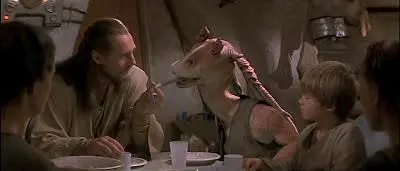A long time ago, in a galaxy far, far away…
It must have seemed like such a good idea at the time. The opening crawl, reminding us of events we hadn’t yet witnessed. The cheeky addition of Episode 4 to the title, as though we had managed to somehow miss parts 1 through 3. The subtitle A New Hope, hinting at decades of past desperation. The insertion of that now iconic phrase, right at the beginning of the film.
In Star Wars, Lucas used every trick he could think of to make us as an audience feel as though the Universe he had invented had a life of its own, a history of its own and that we, as bystanders, were just happening to see one particular chapter in a struggle between Good and Evil which had begun long before our planet were any more than a twinkle in a gas giant’s eye. It was a strategy that paid off brilliantly. Primed from the outset for something different, to its millions of young besotted viewers Star Wars felt realer than real. Out there somewhere, we mused, faces turned to the night sky, Jedis had once battled Imperial Forces. Out there they probably still ran Academies where you could learn to cut people to shreds with lightsabers. Out there twirled mysterious solar systems, stuffed full of planets inhabited by teddy bears.
But it was a strategy with a double edge. The insane popularity of Star Wars left an audience with an unslaked thirst for more. If any of the first three films had tanked, Lucasfilms could have quietly walked away from that teaser of an opening and left the hinted at first three chapters of the saga unwritten. That didn’t happen. It took ten years and vociferous pestering, but in 1993, Lucas committed to producing the trio of films now refered to as the Star Wars prequels. The world sat back and waited. The first film of the three hit the screens six years later in 1999.
And it was only then that it started to become clear that what had made the franchise so successful back in 1977, might just possibly be the same thing that killed it dead.
The Problem with Backstory
Backstory is to plot what the verb ‘to be’ is to prose. You can use it, but with caution and only if you can’t find a better alternative. Backstory, in small doses, forms an essential part of the writer’s tool kit. Characters need motivation to do what they do and some of what motivates them might well have happened in the way back when. We as readers need to know about that stuff, if we are to properly empathize with the people on the page.
Backstory also allows us to start our narrative at the best point: when all the exciting shit happens. Saving Private Ryan starts with D Day on the beaches of Normandy and not when the eponymous Ryan’s brother is making out with the ugly girl in the barn (although that story did make me a little less sad that the Ryan clan was now three members fewer), thus sparing us having to sit through all of the story between then and the good bit, though not the sight of Tom Hanks overacting like a boss in his death scene.
Backstory, correctly handled, fills in the spaces in a story. A piece of dialogue or a reminiscence can lift the veil on previous pain, or explain why a relationship is precious. A story can shift between time periods, drawing parallels between then and now, illuminating the path from there to here and, in expert hands can result in greatness. In a book like Atwood’s Moral Disorder, episodes are recounted with no reference to time frame, forcing you the reader to piece together the sequence of events. Here, backstory becomes story and vice versa, giving you a sense that the past is never really over.
But we’re not all Margaret Atwood, and the use of backstory contains many perils for the unwary writer. Get it wrong with backstory and the fucking up which ensues can be on a truly epic scale.
Only the Boring Bits
The point of using backstory is to tell your audience what they need to know about the things that happened before the narrative begins. Put more simply, its purpose is to spare your audience the boring bits.
Star Wars episodes one to three reverse that process. Instead of condensing the most salient moments of prior action and dropping them into a climactic narrative, these movies take the salient bits and expand them. Instead of taking out the boring bits, these movies are the boring bits.
Instead of being treated to fire fights and saber play, in episodes 1-3 we get Trade Federations, Galactic Senates, separatist movements and emergency powers. It’s all about as exciting as a G8 summit, Okay, let’s be honest it is the G8 summit, only with a couple of remote desert planets and a clone army thrown in. You sense that Lucas, faced with the insurmountable task of topping his original genius, resorted in despair to stealing the minutes of the UN debate on the deployment of peacekeeping forces and delivered those as a script, with the names changed.
None of this was designed to appeal to our inner nine year olds, let alone actual nine year olds. Even the sight of Yoda zipping about the head of Count Dooku, brandishing a lightsaber twice his size could rescue the plots of these films from the deadly grip of having to explain What Happened Before.

Destroying Characters
But if the curse of backstory mired down the plot, its effect on the characters was even more deadly. The prequels had two important questions to answer: how Darth Vader became the biggest and most evil baddie in the Whole Universe and yet also managed to convince a woman to stay with him long enough to start a family AND why he wears that helmet.
We got answers to those questions, but possibly not the right ones. While dropping the ‘I am your father ‘ bombshell formed an indelible part of cinema history, unspooling the story of Anakin from wooden-faced child actor to wooden-faced adult actor added nothing to our enjoyment of the Star Wars Universe. Putting aside the terrible acting (there’s plenty of it in all the movies), this is a case in point about how too much backstory destroys intrigue. It’s interesting to delve into the life history of monsters, but we rarely find satisfactory answers about why someone turns evil, even in real life. Darth Vader works when he’s remote, mysterious and power-crazed. Nothing that happens to him in the first three films truly motivates his transformation, any more than Ted Bundy’s relationship with his mother explains why he turned serial killer. Anakin’s reaction to the tragedies in his life make him seem petulant rather than grief stricken and petulant isn’t really what you want in a supervillain. But we do find out that the mask-wearing isn’t the result of some terrible industrial accident involving an improperly secured landing weeble, although the true story, which involves yet more lightsaber, is possibly slightly less climactic.
The same goes for all the other characters whose backstory unfolds in the prequels. Obiwan Kenobi comes across as a joyless pedant, who fails to connect on any level with his young charge. Emperor Palpatine comes across as prune in a cloak. The only character it’s good to see more of in the prequel is Yoda, who spectacularly kicks ass. If the three episodes had been solely composed of Yoda kicking ass, I would have walked away happy.
The Lesson for Writers
The standard advice about backstory is good advice: avoid it, but if you feel you need it, here’s some tips which might help.
Remember the why
Backstory works when the why questions about character or plot become too loud to ignore. If you sense your reader won’t understand why a piece of action happens or why a character acts as they do and the answer lies at a point before the story begins, then pull in some backstory. But don’t overwhelm the reader with blocks of history or interrupt exciting stuff with anecdotes about the past. Weave the backstory in as much as you can, using lulls in the action as points to regress.
Save backstory for major characters
Don’t make the Darth Vader mistake and waste time explaining what we as an audience can take for granted. Like it or not, Vader is a minor character in Star Wars IV to VI. He’s antagonist, not protagonist, which means he exists to motivate the actions of the main characters (the ones we identify with). This means his own motivation is secondary to the plot. Villains who want to conquer the known Universe and enslave all its peoples rarely need much explanation. We as an audience can take it as read that such characters exist, without delving into what shaped them. Devoting three films to explaining how Anakin became Vader is, in story-telling terms, an exercise we can nimbly file under PWOT.
Keep it short
If you think about it, the important backstory elements in the entire Star Wars prequels could have been delivered to the audience via a couple of conversations between Yoda (who witnessed everything) and the Skywalker twins.
Instead, we got three movies. And Jar Jar Binks.
A New Hope
But that was then and this is now. Against all expectations, the franchise survived the kicking it got from just about everyone when the prequels came out. Bloody but unbowed, the next episode is about to hit the screens. And this time the story finally moves forward. This time we know exactly what happened before. Let’s hope no one involved in making it had a brainwave and thought let’s just give everyone a little recap.
And although it’s become fashionable in the last few weeks to write articles claiming the prequels weren’t really all that bad, anyone who needs convincing that they sucked should take a look at this.
I rest my case.

About the author
Cath Murphy is Review Editor at LitReactor.com and cohost of the Unprintable podcast. Together with the fabulous Eve Harvey she also talks about slightly naughty stuff at the Domestic Hell blog and podcast.
Three words to describe Cath: mature, irresponsible, contradictory, unreliable...oh...that's four.







